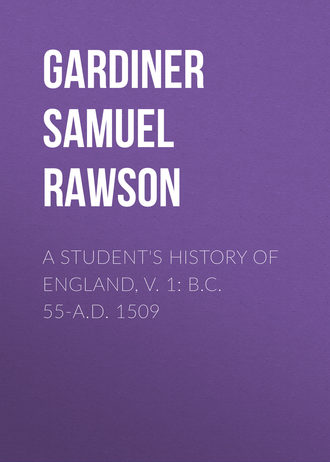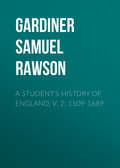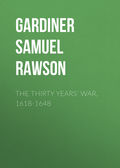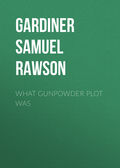
Gardiner Samuel Rawson
A Student's History of England, v. 1: B.C. 55-A.D. 1509

Tattershall Castle, Lincolnshire: built of brick by Ralph, Lord Cromwell, between 1433 and 1455.
14. Beaufort and Somerset. 1442—1443.—In 1442 Henry was in his twenty-first year. Unfeignedly religious and anxious to be at peace with all men, his character was far too weak and gentle to fit him for governing in those rough times. He had attached himself to Beaufort because Beaufort's policy was pacific, and because Gloucester's life was scandalous. Beaufort's position was secured at court, but the situation was not one in which a pacific statesman could hope for success. The French would not consent to make peace till all that they had lost had been recovered; yet, hardly bested as the English in France were, it was impossible in the teeth of English public opinion for any statesman, however pacific, to abandon lands still commanded by English garrisons. Every year, however, brought the problem nearer to the inevitable solution. In 1442 the French attacked the strip of land which was all that the English now held in Guienne and Gascony, and with the exception of Bordeaux and Bayonne captured almost every fortified town. The command in France was given to Cardinal Beaufort's nephew, John Beaufort, Duke of Somerset. Somerset, who was thoroughly incompetent, did not even leave England till the autumn of 1443, and when he arrived in France accomplished nothing worthy of his office.
15. The Angevin Marriage Treaty. 1444—1445.—Henry now fell under the influence of William de la Pole, Earl of Suffolk, a descendant of the favourite of Richard II. Suffolk had fought bravely in France, and had learnt by sad experience the hopelessness of the English cause. In 1444, with the consent of the king and the Parliament, he negotiated at Tours a truce for ten months. In order to make it more lasting there was to be a marriage between Henry and Margaret of Anjou. Her father, René, the Duke of Anjou, was titular king of Jerusalem and Sicily, in neither of which did he possess a foot of ground, whilst his duchy of Anjou was almost valueless to him in consequence of the forays of the English, who still held posts in Maine. Charles had the more readily consented to the truce, because it was understood that the surrender of Maine would be a condition of the marriage. In 1445 Suffolk led Margaret to England, where her marriage to Henry was solemnised. A French queen who brought with her no portion except a truce bought by the surrender of territory could hardly fail to be unpopular in England.

Part of Wingfield manor-house, Derbyshire: built by Ralph, Lord Cromwell, about 1440.
16. Deaths of Gloucester and Beaufort. 1447.—The truce was renewed from time to time, and Suffolk's authority seemed firmly established. In 1447 Gloucester was charged with high treason in a Parliament held at Bury St. Edmunds, but before he had time to answer he was found dead in his bed. His death may, with strong probability, be ascribed to natural causes, but it was widely believed that he had been murdered and that Suffolk was the murderer. A few weeks later Gloucester's old rival, Cardinal Beaufort, the last real statesman who supported the throne of Henry VI., followed him to the grave, and Suffolk was left alone to bear the responsibility of government and the disgrace of failure.

The Divinity School, Oxford: built between 1445 and 1454.
17. The Loss of the French Provinces. 1448—1449.—Suffolk had undertaken more than he was able to fulfil. Somerset had died in 1444, and Suffolk being jealous of all authority but his own, he sent York to govern Ireland. He could not secure the fulfilment of the conditions which he had made with the king of France. The English commanders refused to evacuate Maine, and in 1448 a French army entered the province and drove out the English. Edmund, the new Duke of Somerset, was sent to take the command in Normandy, which had formerly been held by his brother. In 1449 an Aragonese captain in the English service, who had no pay for his troops, having seized Fougères, a place on the frontier of Brittany, for the sake of the booty to be gained, Charles made the attack an excuse for the renewal of the war. So destitute was the condition in which the English forces were left that neither Somerset nor the warlike Talbot (see p. 313), who had recently been created Earl of Shrewsbury, was able to resist him. Rouen fell in 1450, and in 1450 the whole of Normandy was lost. In 1451 the French attacked Bordeaux and Bayonne, two port-towns which, in consequence of their close commercial intercourse with England, had no wish to transfer their allegiance to Charles. England, however, sent them no succour, and before the end of the year they were forced to capitulate. The relics of Guienne and Gascony thus passed into the hands of the French, and of all the possessions which the kings of England had once held on the Continent Calais alone remained.
CHAPTER XXI.
THE LATER YEARS OF HENRY VI. 1450—1461
LEADING DATES
Reign of Henry VI., 1422-1461
Murder of the Duke of Suffolk and Jack Cade's rebellion 1450
First Protectorate of the Duke of York 1453
First Battle of St. Albans and second Protectorate of the Duke of York 1455
Battle of Blore Heath and the discomfiture of the Yorkists 1459
After a Yorkist victory at Northampton the Duke of York is declared heir to the crown, but is defeated and slain at Wakefield 1460
Battles of Mortimer's Cross, St. Albans, and Towton 1461
Coronation of Edward IV. 1461
1. The Growth of Inclosures.—Since the insurrection of the peasants in 1381 (see p. 268) villeinage had to a great extent been dying out, in consequence of the difficulty felt by the lords in enforcing their claims. Yet the condition of the classes connected with the land was by no means prosperous. The lords of manors indeed abandoned the old system of cultivating their own lands by the labour of villeins, or by labourers hired with money paid by villeins in commutation for bodily service. They began to let out their land to tenants who paid rent for it; but even the new system did not bring in anything like the old profit. The soil had been exhausted for want of a proper system of manuring, and arable land scarcely repaid the expenses of its cultivation. For this evil a remedy was found in the inclosure of lands for pasturage. This change, which in itself was beneficial by increasing the productiveness of the country, and by giving rest to the exhausted soil, became oppressive because all the benefit went to the lords of the manors, whilst the tenants of the manors were left to struggle on as best they might. Not only had they no share in the increase of wealth which was brought about by the inclosure of what had formerly been the common land of the manors, but the poorer amongst them had less employment than before, as it required fewer men to look after sheep than to grow corn.
2. Increasing Power of the Nobility.—The disproportionate increase of the wealth of the landowners threw into their hands a disproportionate amount of power. The great landowner especially was able to gather bands of retainers and to spread terror around him. The evil of liveries and maintenance, which had become prominent in the reign of Richard II. (see p. 281), had increased since his deposition. It was an evil which the kings were powerless to control. Again and again complaints were raised of 'want of governance.' Henry V. had abated the mischief for a time by employing the unruly elements in his wars in France, but it was a remedy which, when defeat succeeded victory, only increased the disease which it was meant to cure. When France was lost bands of unruly men accustomed to deeds of violence poured back into England, where they became retainers of the great landowners, who with their help set king and laws at defiance.
3. Case of Lord Molynes and John Paston.—The difficulty of obtaining justice may be illustrated by a case which occurred in Norfolk. The manor of Gresham belonged to John Paston, a gentleman of moderate fortune. It was coveted by Lord Molynes, who had no legal claim to it whatever. Lord Molynes, however, took possession of it in 1448 with the strong hand. If such a thing had happened at present Paston would have gone to law; but to go to law implies the submitting of a case to a jury, and in those days a jury was not to be trusted to do justice. In the first place it was selected by the sheriff, and the sheriff took care to choose such men as would give a verdict pleasing to the great men whom he wished to serve, and in the second place, supposing that the sheriff did not do this, a juryman who offended great men by giving a verdict according to his conscience, but contrary to their desire, ran the risk of being knocked on the head before he reached home. Paston accordingly, instead of going to law, begged Lord Molynes to behave more reasonably. Finding his entreaties of no avail, he took possession of a house on the manor. Lord Molynes merely waited till Paston was away from home, and then sent a thousand men, who drove out Paston's wife and pillaged and wrecked the house. Paston ultimately recovered the manor, but redress for the injury done him was not to be had.
4. Suffolk's Impeachment and Murder. 1450.—A government which was too weak to redress injuries was certain to be unpopular. The loss of the French possessions made it still more unpopular. The brunt of the public displeasure fell on Suffolk, who had just been made a duke, and who, through the queen's favour, was all-powerful at court. It was believed that he had sold himself to France, and it was known that whilst the country was impoverished large grants had been made to court favourites. An outcry was raised that the king 'should live of his own,' and ask for no more grants from his people. In 1450 Suffolk was impeached. Though the charge brought against him was a tissue of falsehoods, Henry did not dare to shield him entirely, and ordered him into banishment for five years. Suffolk, indeed, embarked for the Continent, but a large ship ranged up alongside of the vessel in which he was. Having been dragged on board amidst cries of "Welcome, traitor!" he was, two days afterwards, transferred to a boat, where his head was chopped off with six strokes of a rusty sword. His body was flung on the beach at Dover.
5. Jack Cade's Rebellion. 1450.—Suffolk's supporters remained in office after his death. The men of Kent rose against them, and found a leader in an Irish adventurer, Jack Cade, who called himself Mortimer, and gave out that he was an illegitimate son of the late Earl of March. He established himself on Blackheath at the head of 30,000 men, asking that the burdens of the people should be diminished, the Crown estates recovered, and the Duke of York recalled from Ireland to take the place of the present councillors. Jack Cade's rebellion, in short, unlike that of Wat Tyler, was a political, not a social movement. In demanding that the government should be placed in the hands of the Duke of York, Jack Cade virtually asked that the Duke should step into the place, not of the Council, but of the King—that is to say, that a ruler who could govern should be substituted for one who could not, and in whose name the great families plundered England. It was this demand which opened the long struggle which was soon to devastate the country. At first it seemed as if Jack Cade would carry all before him. London, which had the most to gain by the establishment of a strong government, opened its gates to him. When, however, he was tested by success, he was found wanting. Striking with his sword the old Roman milestone known as London Stone, he cried out, "Now is Mortimer lord of this city." His followers gave themselves up to wild excesses. They beheaded Lord Say and his son-in-law, the Sheriff of Kent, and carried about their heads on pikes. They plundered houses and shops. The citizens who had invited them to enter now turned against them. After a fight on London Bridge the insurgents agreed to go home on the promise of a pardon. Jack Cade himself, attempting to gather fresh forces, was chased into Sussex and slain.
6. Rivalry of York and Somerset. 1450—1453.—In the summer of 1450, Richard, Duke of York, the real leader of the opposition, came back from Ireland. He found that Somerset, who had just returned from Normandy after the final loss of that province (see p. 320), had succeeded Suffolk in the king's confidence. Somerset, however, was not merely the favourite of Henry and the queen. The bulk of the nobility was on his side, whilst York was supported by the force of popular discontent and by such of the nobility as cherished a personal grudge against Somerset and his friends. In 1451 the loss of Guienne and Gascony increased the weight of Somerset's unpopularity. In 1452 both parties took arms; but, this time, civil war was averted by a promise from the king that York should be admitted to the Council, and that Somerset should be placed in confinement till he answered the charges against him. On this York dismissed his army. Henry, however, was not allowed to keep his promise, and Somerset remained in power, whilst York was glad to be allowed to retire unhurt. Somerset attempted to recover his credit by fresh victories in France, and sent the old Earl of Shrewsbury to Bordeaux to reconquer Gascony. Shrewsbury was successful for a while, but in 1453 he was defeated and slain at Castillon, and the whole enterprise came to nothing.
7. The First Protectorate of the Duke of York. 1453—1454.—Henry's mind had never been strong, and in 1453 it entirely gave way. His insanity was probably inherited from his maternal grandfather, Charles VI. The queen bore him a son, named Edward, but though the infant was brought to his father, Henry gave no sign of recognising his presence. It was necessary to place the government in other hands, and in 1454 the Duke of York was named Protector by the House of Lords, which, as the majority of its members were at that time ecclesiastics, did not always re-echo the sentiments of the great families. If only the king had remained permanently insane York might have established an orderly government. Henry, however, soon recovered as much sense as he ever had, and York's protectorate came to an end.
8. The First Battle of St. Albans and the Duke of York's Second Protectorate.—The restoration of Henry was in reality the restoration of Somerset. In 1455 York, fearing destruction, took arms against his rival. A battle was fought at St. Albans, in which Somerset was defeated and slain. This was the first battle in the wars known as the Wars of the Roses, because a red rose was the badge of the House of Lancaster, to which Henry belonged, and a white rose the badge of the House of York. After the victory York accompanied the king to London. Though the bulk of the nobility was against him, he had on his side the powerful family of the Nevills, as he had married Cicely Nevill, the sister of the head of that family, the Earl of Salisbury. Still more powerful was Salisbury's eldest son, who had married the heiress of the Beauchamps, Earls of Warwick, and who held the earldom of Warwick in right of his wife.30 In June 1455 the king was again insane, and York was for the second time named Protector. This Protectorate, however, did not last long, as early in 1456 the king recovered his senses, and York had to resign his post.

A sea-fight: from the 'Life of Richard Beauchamp, Earl of Warwick:' drawn by John Rous about 1485.
9. Discomfiture of the Yorkists. 1456—1459.—For two years Henry exercised such authority as he was capable of exercising. In 1458 he tried his hand at effecting a reconciliation. The chiefs of the two parties walked hand in hand in procession to St. Paul's, York himself leading the queen. The Yorkists founded masses for the repose of the souls of their enemies slain at St. Albans, and paid money to their widows. It seemed as if the old practice of the weregild (see p. 32) had been unexpectedly revived. The spirit which had made weregild possible was, however, no longer to be found. Warwick retired to Calais, of which he was governor, and sent out vessels to plunder the merchant ships of all nations. When he was summoned to Westminster to give account of his actions, a quarrel broke out there between his servants and those of the king. Believing his own life to be in danger, he made his way back to Calais. The Yorkists spent the winter in preparing for war. In the summer of 1459 Lord Audley, sent by the queen to seize the Earl of Salisbury, was defeated by him at Blore Heath, in Staffordshire. Later in the year the two parties with their whole forces prepared for a battle near Ludlow, but the Yorkists found themselves no match for their enemies, and, without fighting, York, with his second son, the Earl of Rutland, took refuge in Ireland. His eldest son Edward, Earl of March, with Salisbury and Warwick, made his way to Calais.

Effigy of Sir Robert Harcourt, K.G. (died 1471): from his tomb at Stanton Harcourt, Oxon; showing armour worn from about 1445 to 1480.
10. The Battle of Northampton and the Duke of York's Claim to the Throne. 1460.—In 1460 the Yorkist Earls of Salisbury, Warwick, and March were once more in England. They defeated the royal army at Northampton and captured the king. York returned from Ireland, and, as soon as Parliament met, took an unexpected step. If hereditary descent was to count for anything, his claim to the throne was superior to that of Henry himself, as he was the heir of Edward III. through his mother Anne, the sister of the last Earl of March.31 The Duke of York now placed his hand on the throne, claiming it in right of birth. The Lords decided that Henry, to whom they had sworn oaths of fealty, should retain the crown, but that York should succeed him, to the exclusion of Henry's son, Edward, Prince of Wales.
11. The Battle of Wakefield. 1460.—The struggle, which had at first been one between two unequal sections of the nobility, each nominally acknowledging Henry VI. as their king, thus came to be one between the Houses of Lancaster and York. The queen, savage at the wrong done to her son, refused to accept the compromise. Withdrawing to the North, she summoned to her aid the Earl of Northumberland and the Lancastrian lords. The North was always exposed to Scottish invasions, and the constant danger kept the inhabitants ready for war, and strengthened the authority of the great lords who led them. For the same reason the people of the North were ruder and less civilised than their fellow-countrymen in the South. Plunder and outrage did not come amiss to men who were frequently subjected to plunder and outrage. An army composed of 18,000 of these rough warriors placed itself at the queen's disposal. With these she routed her enemies at Wakefield. York himself was slain. His son, Rutland, was stabbed to death by Lord Clifford, whose father had been slain at St. Albans. Salisbury was subsequently beheaded by the populace at Pontefract. By command of Margaret, York's head was cut off, and, adorned in mockery with a paper crown, was fixed with those of Salisbury and Rutland above one of the gates of York.
12. The Battle of Mortimer's Cross and the Second Battle of St. Albans. 1461.—The battle of Wakefield differed in character from the earlier battles of the war. They had been but conflicts between bands of noblemen and their armed retainers, in which the general population took little part, whilst the ordinary business of the country went on much as usual. At Wakefield not only were cruel passions developed, but a new danger appeared. When Margaret attempted to gain her ends with the help of her rude northern followers, she roused against her the fears of the wealthier and more prosperous South. The South found a leader in York's son, Edward. Though only in his nineteenth year, Edward showed that he had the qualities of a commander. Rapid in his movements, he fell upon some Lancastrian forces and defeated them on February 2, 1461, at Mortimer's Cross. In the meanwhile Margaret was marching with her northern host upon London, plundering and destroying as she went. Warwick, carrying the king with him, met her on the way, but in the second battle of St. Albans—fought on February 17—was driven back, leaving the king behind him.
13. The Battle of Towton and the Coronation of Edward IV. 1461.—With a civilised army at her back, Margaret might have won her way into London, and established her authority, at least for a time. Her unbridled supporters celebrated their victory by robbery and rape, and Margaret was unable to lead them forward. The Londoners steeled their hearts against her. Edward was marching to their help, and on February 25 he entered London. The men of the neighbouring counties flocked in to his support. On March 2 the crown was offered to him at Clerkenwell by such lords as happened to be in London. On his presenting himself to the multitude in Westminster Hall, he was greeted with shouts of "Long live the king!" Edward IV. represented to peace-loving England the order which had to be upheld against the barbarous host which Margaret and the Lancastrian lords had called to their aid. He had yet to justify the choice. The northern host had retreated to its own country, and Edward swiftly followed it up. His advanced guard was surprised and driven back at Ferry Bridge; but his main army pressed on, and on March 29 gained a decisive victory at Towton. The slaughter of the defeated side was enormous. Margaret escaped with Henry to Scotland, and Edward, returning southwards, was crowned at Westminster on June 29.






